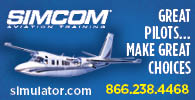The Model 690A was the twenty-third Turbo Commander to be placed into production, the first 20 by the Aero Commander Division of North American Rockwell Corporation at Bethany (Wiley Post Airport), Oklahoma City, Oklahoma; the next 83 by the Commander Aircraft Division of Rockwell International Corporation; and the last 142 by the General Aviation Division of Rockwell International Corporation.
The 245 examples were built between April 1973 and September 1976, serial numbers 11100 through 11344.
Of these, 42 were initially certified in 1973; 84 in 1974; 88 in 1975; and 31 in 1976. A factory document describes the Model 690A as “Certified April 25, 1973. Similar to 690. Major differences are: a) maximum altitude increased from 25,000 to 31,000; b) enlarged dorsal fin and longer tail cone; c) increased cabin pressure differential from 4.2 to 5.2 psi; and d) heated windshield added. Wing and empennage de-ice equipment became standard.”
The Model 690A was indeed certified on April 25, 1973, under Type Certificate 2A4 and had AiResearch TPE331-5-251K engines. The first 228 examples had 106-inch-diameter Hartzell HC-B3TN-5FL/LT10282HB+4 propellers, while the last 17 used the HC-B3TN-5FL/LT10282B+4. TPE331-5-252K engines can be installed under STC No. SA1024SO and various variants of the TPE331-10T “Dash Ten” engines under STC No. SA236CH. Gross weight is increased to 10,250 pounds, or 11,000 pounds with STC No. 10173SE. Cabin pressure differential is 5.2 psi giving a 13,000-foot cabin at 33,059 feet and a sea-level cabin at 11,595 feet.
There were two major changes from the Model 690. One was a fuselage redesign to raise the cabin pressure to 5.2 psi. All static and fatigue testing of the redesigned pressure vessel was performed at Bethany. Premature fatigue failures led to extensive pressure-vessel skin gauge changes and restarting of the fatigue testing. The other major change was for certification of laminated glass windshields with an internal electric grid wire system for de-icing. These units were manufactured by the Pittsburgh Plate Glass Company. This replaced the alcohol spray system used on previous Turbo Commanders for windshield anti-ice. This windshield was later certified by the U.K. CAA for a two-pound bird strike requirement.
A cosmetic dorsal fin introduced on the Model 690A extended from the base of the vertical fin forward towards a point just before the intake for the pressurization system, where it was then truncated. A longer, more pointed tail cone was also introduced. From serial number 11249, the VOR antennae were mounted in a lower position on the vertical fin.

A digital image taken by Jarrod Wilkening on February 10, 2016, at Conroe, Lone Star Executive Airport, Texas, depicts N911KC, which is serial number 1130. Originally certificated on October 8, 1975, as N9181N, the factory had installed main gear-mounted landing lights. It was sold new to Shepherd Construction Company Inc of Atlanta, Georgia and duly re-registered as N471SC. Having been sold to Bean Industries Inc., it was re-registered as N80TB in June 1993. In March 2009, Eagle Creek Aviation Services Inc completed a Grand Renaissance upgrade, with Dash Ten engines. Also at that time nose lights with a Pulselight kit were added as well as Commander-Aero winglets. Re-registered by Eagle Creek as N490KC, it was sold on May 1, 2009, to the County of Kern, in Bakersfield, California and operated by their sheriff’s office. It was re-registered by them as N911KC on August 5, 2014.
Model 690A, N690CL
A digital image taken by Chris Haag on March 23, 2015, at Berne, Switzerland, depicts N690CL, which is serial number 11153. Originally certificated on February 19, 1974, as N57074, it had provision for Wild RC-8 and RC-10 cameras installed on July 15, 1974 in accordance with STC SA1584SW. It was later re-registered as N53RF after being purchased by Federal Airways Corp., of Potomac, Maryland. By June of 1975, a Model 690B dorsal fin had been installed, followed by the installation of nose recognition lights by June 1997. A further modification involved the installation of Javelin 50 gallon “slipper” tanks in May 2009. According to the FAA Registry, it is back to the original N-Number.
Barry Collman’s lifelong interest in airplanes began when he was growing up in a house located underneath the downwind leg to busy Northolt aerodrome, an R.A.F. base near London-Heathrow airport. As a young teenager he discovered airplane “spotting”–hobbyists’ observation and logging of aircraft by make, model, and registration number. The hobby began to grow into a passion as Collman joined a club of like-minded spotters. At one point he purchased a copy of the January 1966 U.S. Civil Aircraft Register, and thumbing through it came upon the Aero Commander. He was hooked. Eventually he acquired every available FAA microfiche file on Commanders, and since 1995 has made annual pilgrimages to Oklahoma City to sift through FAA records. He now has a database with about 100,000 records as well as a collection of negatives, slides, photographs, digital images, magazines, brochures, knick-knacks–and a very understanding wife. This series on Commander production history originally was written for the Twin Commander Flight Group, of which he is an enthusiastic member.


 Info on Model 690A, N690CL,
Info on Model 690A, N690CL,
